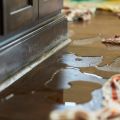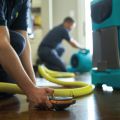9/23/2020
How Slow Water Damage from Roof Leaks Can Cause Mold Build-up in Atlanta, Georgia
10/19/2020
Every homeowner dreads the appearance of leaks, which could stem from a variety of sources and cause minor damages that could escalate to a full-blown problem when not repaired immediately.
The most common sources of water leaks in the home are broken appliances, burst pipes, and faulty fixtures. Some leaks, however, are indirectly caused by another problem that has remained unaddressed for quite some time. One of these is a roof leak. This problem could get worse once the winter months start, so it is proactive to learn about roof leaks, what they can do to your home, and how you can deal with them beforehand.
In this article, ServiceMaster by Lovejoy discusses the role of slow water damage from roof leaks in causing mold build-up.
What causes roof leaks?
Your roof's structural integrity can weaken over time due to repeated exposure to the sun, rain, and other elements. Most homeowners do not notice that their roof needs a repair until a leak appears. When this occurs,
not only do you have to have the roof issue repaired, but now you need to address any damage the leak has caused to the interior of the home.
not only do you have to have the roof issue repaired, but now you need to address any damage the leak has caused to the interior of the home.
The most common causes of roof leaks in the home mostly point to roofing problems. Read them below and learn how to prevent them.
Broken or missing shingles
During severe weather phenomena such as hurricanes or strong storms, your roof shingles can be damaged. Make it a routine to check for broken or missing shingles after a storm to get it fixed or replaced immediately.
Improperly installed or damaged flashing
If your flashing has not been installed by a licensed roofer or if it has been damaged, chances are it might direct water and moisture into your home instead of away from it.
Incorrect roofing materials
Different roofs require different roofing materials to be able to operate properly. For example, a roof with a pitch (steepness) that's less than 3:12 requires materials designed specifically for a flat roof. If your roof was not constructed with the correct and proper fitting materials, leaks can happen.
Plumbing problems
Always check the pipes in your roof for indications of wear and tear and perform the necessary repair as early as possible. Leaks can result from damaged or old pipes.
Ice dams
Ice and snow can collect on the roof especially during cold winter months. Ice dams occur when there is a mass of ice that accumulates on the roof and obstructs the flow of melting snow. Because the water cannot drain, it backs up into the home and causes damage to ceilings and adjacent areas.
Incorrect repairs
Improper and ineffective work done on the roof could eventually lead to more roof problems. Always call a licensed roofer to ensure that the repair is correctly done.
Obstructed or clogged gutters
Clogs in the gutter result from leaves and other foreign debris. This blockage causes seepage when it pools in one area of the roof, and proceeds to damage walls, ceilings, and insulation. Always clear your gutters before heavy rains or snow to prevent clogging. Trim tall trees around the roof to help lessen leaf accumulation.
Broken or missing shingles
During severe weather phenomena such as hurricanes or strong storms, your roof shingles can be damaged. Make it a routine to check for broken or missing shingles after a storm to get it fixed or replaced immediately.
Improperly installed or damaged flashing
If your flashing has not been installed by a licensed roofer or if it has been damaged, chances are it might direct water and moisture into your home instead of away from it.
Incorrect roofing materials
Different roofs require different roofing materials to be able to operate properly. For example, a roof with a pitch (steepness) that's less than 3:12 requires materials designed specifically for a flat roof. If your roof was not constructed with the correct and proper fitting materials, leaks can happen.
Plumbing problems
Always check the pipes in your roof for indications of wear and tear and perform the necessary repair as early as possible. Leaks can result from damaged or old pipes.
Ice dams
Ice and snow can collect on the roof especially during cold winter months. Ice dams occur when there is a mass of ice that accumulates on the roof and obstructs the flow of melting snow. Because the water cannot drain, it backs up into the home and causes damage to ceilings and adjacent areas.
Incorrect repairs
Improper and ineffective work done on the roof could eventually lead to more roof problems. Always call a licensed roofer to ensure that the repair is correctly done.
Obstructed or clogged gutters
Clogs in the gutter result from leaves and other foreign debris. This blockage causes seepage when it pools in one area of the roof, and proceeds to damage walls, ceilings, and insulation. Always clear your gutters before heavy rains or snow to prevent clogging. Trim tall trees around the roof to help lessen leaf accumulation.
Cracked chimney
Check the chimney for cracks along the top of the mud cap. Seal any hole in the mortared joints where the chimney and the roof connects. Repair loose, missing, or damaged shingles in the surrounding area.
Check the chimney for cracks along the top of the mud cap. Seal any hole in the mortared joints where the chimney and the roof connects. Repair loose, missing, or damaged shingles in the surrounding area.
What are the signs of a roof leak?
ServiceMaster Restore lists the common signs of roof leaks as follows:
- Watermarks on ceilings and/or walls
- Discolored areas on ceilings and/or walls
- Darkening of ceiling paint
- Peeling paint around skylights or dormer windows
- Peeling, cracked, or bubbled plaster
- Mold growing around the chimney
- Wood rot in the attic, around skylights or dormer windows
- Discolored wood in the rafters (may appear like a reddish, rusty color)
- Crumbling, deteriorating drywall
- Musty or mildew smell in the attic
- Mold on attic insulation
- Water seepage during heaving rainstorms or during a snowmelt
If you notice the signs of a roof leak, it is recommended to contact a professional water damage restoration service in Atlanta, Georgia, such as ServiceMaster by Lovejoy, as soon as possible.
How do roof leaks contribute to mold build-up?
- Leaks from roof problems could contribute to slow water damage within the ceiling and the surrounding walls. Over time, this damage could spread to other areas of the house and cause the rotting of drywall and wooden structural materials.
- Mold spores from growth caused by a leaky roof can spread through the home via the HVAC system.
- Consequently, mold growth occurs with the presence of moisture. It must be noted that mold can grow in as little as 48 hours.
- While mold is harmless in small quantities, the presence of mold in your home is a potential health risk, especially to those with allergies, asthma, and other respiratory problems.
- People with compromised immune systems can also suffer from mold exposure. Thus, deal with roof leaks and mold by determining the cause of the leak and having it repaired.
Call the Experts for Roof Water Damage Repair and Mold Removal in Atlanta, Georgia
Speed is a requisite for mold growth prevention. When it comes to professional water damage restoration and mold remediation in Atlanta, Georgia, trust ServiceMaster by Lovejoy. Our professional water damage restoration process includes:
- Inspection and Assessment
- Water Removal
- Structural Drying and Dehumidification
- Cleaning and Disinfection
- Restoration and Repairs
When faced with water damage and mold caused by a roof leak, rely on the professionally trained teams at ServiceMaster by Lovejoy to handle the remediation process safely, effectively and thoroughly. Call us at 678-293-0297 for Conyers, GA clients or 770-992-1575 for Roswell, GA clients.
Other articles and publications:
Water damage losses are separated into three categories, defined by the source and the spread of the water. Learn more.
Water can be extremely destructive, usually resulting in thousands of dollars of damages. Read this article about emergency water damage repair in Covington, Georgia by ServiceMaster by Lovejoy.
8/20/2020
Learn how to handle a leak in your commercial building. For Conyers water damage restoration, contact ServiceMaster by LoveJoy at (678) 293-0297.
5/21/2021
The experts at ServiceMaster by LoveJoy have prepared a list of tips to minimize melting ice damage this winter and prevent expensive repairs. Learn more.
2 Comments
2/18/2021
One of the most critical steps in the water damage restoration process is determining the kind of contamination being dealt with. Learn about Category 2 water or gray water in this article.
2/18/2021
Does renters insurance cover water damage? Learn more in this article by ServiceMaster by LoveJoy.
2/18/2021
Articles and publications of other companies:
Residential water damage stems from a variety of causes. Learn what causes and how you can prevent water damage in this article.
7/22/2021
Call (678) 264-3310 ServiceMaster of Roswell for water damage restoration, repair & cleanup service. We are on-call 24/7. Insurance Preferred Vendor
6/22/2021
Many factors cause water damage. It occurs whenever water begins to collect someplace it shouldn’t, whether that be your kitchen floor, walls, the corner of your basement, or any area in your home.
9/17/2020
Water damage is a time-sensitive process. If the property isn’t dried promptly enough and with the right equipment, it can lead to mold issues
10/22/2020
Not all water damages are created equal. Learn more about the causes, categories, and classes of water damage in this article by ServiceMaster of Cobb.
9/17/2020
Read about the sources, signs, and prevention of basement water damage in this article by ServiceMaster of Cobb, Georgia and Tennessee's leading disaster restoration, cleanup, and repair company.
10/22/2020







